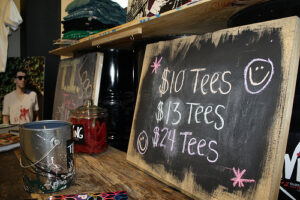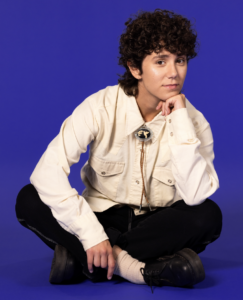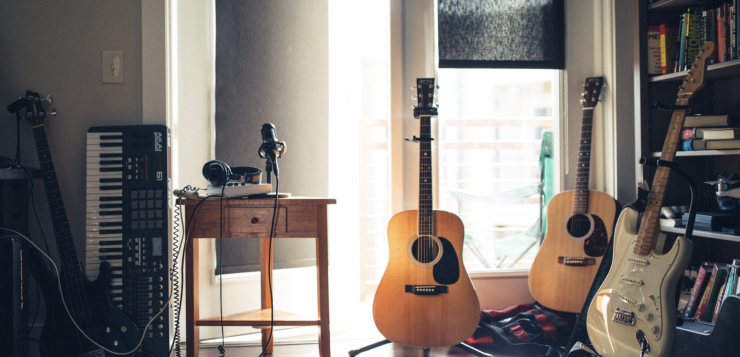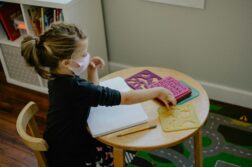
The excitement of the long merch line between my opening set and Daisy the Great’s headlining performance is well underway. I try to make a genuine connection with each audience member in line, utilizing skills from my past retail jobs to make sure each person gets the right size shirt so the line can move with alacrity. It’s the hardest part of the night, but also the most important.
A woman, who looks to be in her early forties, asks for a medium T-shirt and tells me, “I grew up listening to women’s music—Ani DiFranco, The Indigo Girls, Dar Williams. I love your music so much because it reminds me of them!”
Although I wish I could remember every fan interaction I’ve ever had, meeting thirty to fifty new people every night for a month tends to make the faces and conversations blend together. However, this interaction still dances around in the back of my head. On one hand, the comparison was a high compliment, and made me feel warm. She listed some of my favorite artists, singer-songwriters who defined modern folk in a way that was queer, feminist, and emotional. The women she mentioned without a doubt paved the way for the current explosion of queer folk artists singing their joys, sorrows, and frustrations to acoustic guitars in their bedrooms. All three artists’ songs frequent the playlist that has inspired me and made me into the artist I am today.
On the other hand, her comment wasn’t affirming to me as a non-binary person. I don’t fully identify as a woman; I use they/them pronouns and feel more comfortable with an androgynous gender presentation. Although I love these artists deeply and wholly, her comment made me question whether or not I make what is considered ‘women’s music;’ it made me question if women’s music still exists. It motivated me to redefine vulnerable queer folk music as an entity outside of “women’s music,” but a genre heavily influenced by it.
I often dream about a Lilith Fair Revival. Lilith Fair was an all-female festival created by Sarah McLaughlin and others in the late ‘90s with a lineup of mostly folk artists, many of whom were queer. In many ways, Lilith Fair defined what my fan was most likely referring to as “women’s music.” At the time, McLaughlin’s idea was radical; the music industry was (and still is) dominated by men that a women’s festival of music that wasn’t afraid to be earnest, soft, and vulnerable changed the music industry forever. They attempted to revive the festival in 2010, but discovered that the festival didn’t retain the same relevance. If they were to revive the festival this year with the same guidelines as they had in the ‘90s, explicitly calling it an “all-female festival,” I think it would lose even more relevance. Many of the artists in this genre no longer even identify as women, and I’m one of them.

The LGBTQ community has grown and changed so much since the first Lilith Fair in 1997, and in the past 10 years specifically, this growth and change has been exponential. I didn’t even learn that there was an option to identify one’s gender outside of the binary until my first year of college in 2015. I started exploring my own gender identity in 2020, prompted by my increased visibility as a musician. I discovered how uncomfortable I was being seen in what was my current gender presentation at the time, and experimented with masculinity and androgyny in a way that was incredibly exciting and affirming. I love being non-binary and I love my community, but there are times when the explicit exclusion of non-binary and trans people from “women’s spaces” feels painful and outdated.
When I look at the lineups from past Lilith Fairs, I see names like Tracy Chapman, the Indigo Girls, Tegan and Sara, and Sinead O’Connor. Although they all identify/ied as women, all of these musicians express/ed their genders in unique, queer, androgynous ways that, in my opinion, fall somewhere outside of the stereotypical markers of femininity. I wonder sometimes if their pronouns might be different if they had been born later; if they had access to the language, community, and acceptance that Gen Z queer folk artists have access to today. Lesbianism has always been associated with gender nonconformity, and language has often failed us. My friends and I often joke together that “my gender is just dyke.”
I don’t have all the answers, but I know spaces that intentionally amplify the voices of marginalized communities in music and make space for their fans to gather together, are essential to our liberation. The concept of “women’s music” and Lilith Fair as it looked in the ‘90s may be outdated, but I have dreams of a large scale queer folk festival that mimics Lilith Fair’s ethos in a modern, inclusive way. A festival of what used to be known as “women’s music” featuring non-women, trans women, and cis women alike. The language may still be clunky and developing, but it is imperative to parse through the awkwardness to create safe spaces for queer folk music.

A key player in the new wave of contemporary folk artists, Olive Klug is known for their beautiful tone, vividly honest storytelling, and modern lyrical sensibility. Klug currently resides in Los Angeles but was raised in Portland, Oregon. Twenty-six years old but a kid at heart, Olive is making songs on TikTok (173.5K+ followers) and displaying a deep sense of sincerity and genuine excitement that has rallied their fans and supporters along the way. You can listen to their debut album, Don’t You Dare Make Me Jaded, and find more information about their upcoming tour, here.






